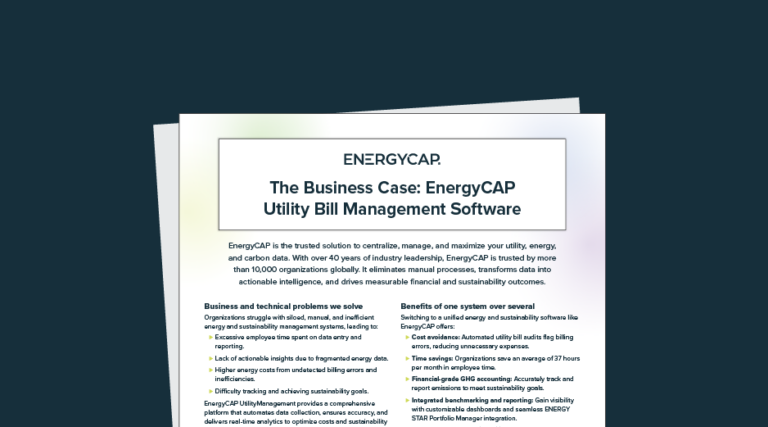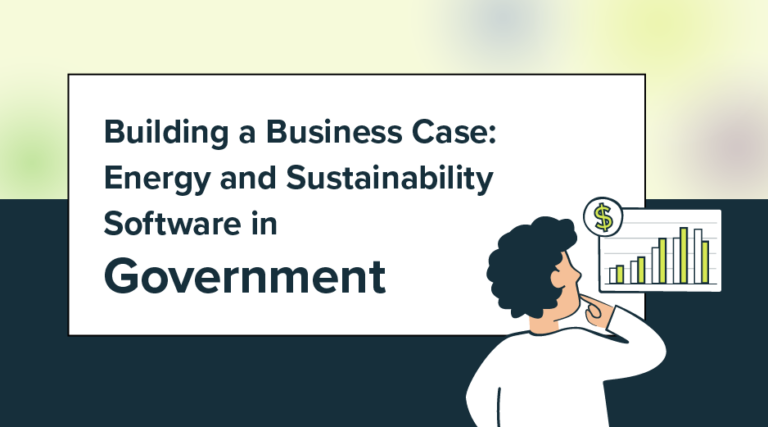Legacy in the Dictionary
Legacy as a noun refers to something handed down from a predecessor. There is a suggestion of lasting value, permanence, and worthy accomplishment. By contrast, legacy as an adjective is typically applied to an item that is rapidly diminishing in value over time. In the computer industry, legacy equipment is outmoded and of little utility. In the software industry, legacy software is code that has served a purpose in years past, but has been surpassed by newer developments. It’s obsolete and essentially out of date. It’s barely functional, and needs to be replaced.
This raises an interesting question: How does one build a legacy in energy management without becoming legacy in the field? What are the elements of energy management that can create lasting value?
Some energy managers think that if they can get that one big project approved by senior management and successfully installed, that big shiny piece of hardware will be their energy management legacy. Unfortunately, big shiny pieces of hardware, although they might be valuable for a number of years, eventually become legacy energy management.
Think back to the early days of energy management in the 1970s and 1980s— back in the time of oil embargoes and international energy crises. Those of us who were there saw all sorts of expensive automation systems being installed in government buildings. However, very few (if any) of those systems are still in operation today. They have been replaced.
This observation suggests that an exclusively project-oriented or hardware-focused understanding of legacy is probably short-sighted and deficient. For purposes of this eBook, we will look at legacy from a wider perspective
Leaving an Energy Management Legacy
An energy management legacy is one that changes the organizational culture at the highest levels. An energy management legacy makes efficiency and sustainability permanent priorities, so that when one project has been completed, the organization is still moving forward—continuing with efforts to drive down energy consumption using the most energy-efficient means possible.
Kroger and Continuous Improvement
Consider the Kroger Company as an example. Kroger is the largest U.S. grocery retailer. They’re the 23rd largest company in the U.S. in revenue— about $100 billion a year in revenue, the second largest retailer behind Walmart, and the fifth largest retailer in the world. Kroger has been in business for 131 years and has 375,000 employees. They are a very significant organization.
So what have they done in energy management? Kroger has left a legacy. When you compare Kroger’s current energy use to their energy use in base year 2000, they’ve driven down their rate of energy use per square foot in their grocery stores by almost 35 percent. They’ve implemented cutting-edge technologies and building controls and refrigeration controls to do that. And they have adopted EnergyCAP software for their utility bill management and cost avoidance calculations. Kroger already has 557 ENERGY STAR-rated stores.
How did Kroger do this, and how do they continue to do this?
Kroger’s success is due primarily to a strategy of continuous improvement. They have adopted a cyclic process called Plan-Do-Check-Adjust (PDCA). In other places, this process is called PIFA: Plan-Implement-Follow up-Adjust.
If you study the ISO 50001 Energy Management Guide, it’s all about the cycle: planning, implementing, following up, and then making adjustments that feed back into the plan. ISO 50001 is non-specific. It doesn’t say, “In order to be an effective energy manager, you have to do this project and that project and you have to install this technology.” It avoids naming measures or technologies. But it is specific about the cycle: Planning, implementing, following up, and then adjusting, using what you’ve learned and feeding that knowledge back into the plan—then doing this over and over, so that the organizational philosophy becomes a process of continuous improvement.
If Kroger can do it, why can’t you?
Obstacles to Legacy
If you’re an energy manager, a potential obstacle to leaving an energy management legacy is a situation where senior management does not share the same priorities as you do. Your priorities include energy management and energy efficiency. That’s what you were hired to do. But senior level managers might, and often do, have other priorities—possibly even competing priorities.
Another significant obstacle can be a lack of energy performance metrics. The problem is seldom that data is not available, but rather that data is dispersed in multiple archives, locations, and formats, making it tedious and time-consuming to perform even the basic benchmarking and trend evaluations that would provide direction for future energy management activity.
Related to the data issue is accountability. Often, an organization may not have formally designated or delegated authority and responsibility for energy management tasks. This lack of protocol and specificity can make it very difficult for anyone to “step to the plate” and take ownership and management of energy initiatives. Without a foundation of recognized responsibility, it becomes very difficult to build a legacy.
Another frequent obstacle to legacy is confusion about the direction and/ or focus of energy management efforts. It’s hard to get somewhere when no one is certain where anyone is going!
A final obstacle to legacy is simply a lack of education. Energy stewardship is a win-win proposition—the organization saves energy and money, which can be redirected into more profitable and beneficial programs. But if people don’t know how to save, they won’t.
All these obstacles can be overcome. Here are five steps you might take along the road to leaving your own energy management legacy:
5 Steps toward Legacy
STEP #1 Align senior management priorities with energy management goals
Often, one of the most difficult steps toward legacy is achieving administrative buy-in to your energy management vision. Since organizational priorities are based upon the value to the organization, it is important to tie the vision to ROI. As Jerry Maguire might say, “Show me the money.”
So how can you get from a project-centered energy management focus to an integrated, company-wide commitment?
What you have to do is consistently demonstrate the value of energy efficiency, because at the end of the day, the priorities in organizations are based upon the value to the organization. Equate energy efficiency with net positive value. Remember, value is not just bottom-line dollars—it could be expressed in other ways, such as:
- increased public recognition
- a greener public image for your organization
- increased building value
One of the problems or challenges that you will face in this process is just being heard amidst all the clutter—all the noise. When upper management is dealing with the big picture issues, it can be like standing in the middle of Times Square. Everything is vying for attention. There are too many bright, shiny lights. It’s difficult to cut through all of that noise of competing projects, programs, and priorities, any one of which might challenge and preempt your energy management objectives. So you must be sure that management has some tangible ways in which they can understand the value that you bring, which leads us to the next step in leaving an energy management legacy.
STEP #2 Implement energy tracking across your organization
If you want to demonstrate value, you have to measure your energy use and cost; then you have to report it.
As management gets accustomed to seeing energy reports, and as you put an effective energy information system in place to ensure comprehensive and reliable reporting, this helps to cut through the clutter and the noise with something familiar that management will become accustomed to looking for. This is a very important step.
If you can tie the electronic receipt of utility bills into an energy management platform, and tie that into your accounts payable system, it is even better. Then energy management will have become an integral part of a critical business process that your organization simply can’t do without.
STEP #3 Add accountability for energy efficiency performance
Energy reports are one thing, but being held accountable for performance is even more important. So the third recommendation would be that after you implement energy tracking and reporting systems, you implement accountability processes that raise awareness, reward success, and help you to track your performance.
EXAMPLE: Montgomery County Public Schools
Montgomery County Public Schools is the largest school district in Maryland, with 12,000 teachers, 200 school buildings, and 142,000 students—a large operation! They created a program called SERT back in 1994, and they set up the energy tracking system for that. So that goes back more than 20 years now. SERT stands for School Energy and Recycling Team. Today, the SERT program is still going strong, and they’ve reported $2.2 million in cost avoidance just in the most recent school year! What made the SERT program so successful and gave it such long life?
In a nutshell, success can be traced to the engagement of key stakeholder groups, and the visible and competitive nature of the SERT behavioral programs. SERT leaders have learned how to engage the staff, the students, and the community so that everyone has a stake in the energy management program. With ongoing reporting and visibility, stakeholders can easily see progress and losses. Along with competitions, the program has built in recognition and awards. These activities keeps people excited and involved. Together, the building service team, those at the custodial staff and the maintenance staff, administration, staff, students, and community members have maintained a very viable successful program, and there is something to be learned from their long-term success.
STEP #4 Create intermediate and long-term “stretch” goals
As mentioned previously, energy management is not a one-time project. Projects, regardless of cost, are generally shorter-term priorities. Building an energy management legacy also involves setting intermediate and long-term “stretch” goals for your energy management program. An intermediate goal might be to have all of your buildings benchmarked by ENERGY STAR. A stretch goal could be to attain an average building rating of 75 on the ENERGY STAR scale. Another long-term visionary stretch goal might be “X” number of net-zero energy buildings, perhaps 40 years in the future. Will these stretch goals ever be achieved? Not unless you set them! Net-zero would have been dismissed as impossible just a few years ago.
But if you consider the pace of technology, who can tell what is going to be available in 2050?
Sometimes positive changes don’t take hold because there is no long-range goal. Net zero energy by 2050 would be a visionary long-range goal! But along with the goals, make sure to develop strategies for achieving them. Strategy involves the specific ways that the goals are going to be pursued. Strategies often take shape in an organizational Energy Management Plan. Having a written out strategy that is periodically revisited and revised can be invaluable for achieving an energy management legacy. And sound strategy is also important for management buy-in. The Plan can provide a strategic model for savings that incorporates both behavior-based programs and retrofits.
STEP #5 Turn It Off/Set It Back/Tune It Up
Many organizations miss a critical step in creating an energy management legacy because energy management leaders are thinking only in terms of retrofits and capital improvements. There is a huge role that behavior-based energy management can play by tapping into the interest, creativity, and enthusiasm of employees and staff (the users of the buildings). Volunteer programs have to be more than just a little sticker on the light switch that says, “Please turn off lights when you leave the room.” But that is the first step! Number two is to turn it back, or set it back—to control it. This has to do with dialing back the thermostats, and creating a setback policy for the entire organization, with all the necessary procedural detail. Then staff knows exactly what the operating hours are, and what sections of the facility can be adjusted when not in use. And after you’ve turned off things that you don’t need, and set back things when you can, then the third element is “tuning up”. This means being as energy efficient as possible, which can include all retrofit projects, like replacing the boiler, or installing LED lighting.
Elements of a Legacy
Loudoun County is the third largest school district in Virginia, located in suburban Washington, just west of Washington D.C.
For years, the school district has been one of the fastest-growing in the nation due to a population boom in northern Virginia. Today, the district enrolls about 70,000 students.
The Loudoun County School District instituted a comprehensive energy management program in 1993, and has documented a 20-year cost avoidance of $62 million. This is a very significant figure. They have also won an ENERGY STAR National Excellence Award from the EPA for five years in a row, and the district has received the Governor’s Environmental Excellence Award.
When you see a program that is so successful and viable after twenty years—a program that is still routinely touted by the superintendent, the school board, and local media—then you know you are dealing with an energy management legacy!
What is it that has enabled a program like this to remain viable for so many years when statistically, the great majority of do-it-yourself school district energy management programs have fallen by the wayside? What was Loudoun County’s path to legacy?
Education
First, they have a very effective behavior-based educational program that has resulted in a shift in individual and organizational behavior—a genuine culture change. Everyone in the district is taught the priority of energy management, and the value that energy management brings to the organization.
Involvement
Second, they have successful people-based energy conservation initiatives. Loudoun County has been very successful in encouraging volunteerism, which they prefer over mandates. Their mantra is “find your advocates.” Find those people who are emotionally interested in saving energy—who see that as a life mission. The district finds them and encourages them, with financial and logistical support, rewards, and recognition from the highest administrative levels.
The district also reinforces the concept that energy is used by people. Some might say that energy is used by buildings. But the district doesn’t look at energy that way. By focusing on people, and not things, the district is getting buy-in from folks who have been empowered to make a difference in building energy consumption, and they’ve done an excellent job of doing that.
But their energy management program doesn’t stop with behavior.
Codification
Another vital step has been what we might call codification. They have actually written down their support services policies—internal regulations that specify best practices and provide detailed energy efficiency guidelines. As part of that process, energy management has become more than just a good idea, and has become an organizational imperative. And when you can help move an organization to that point—the codification point—you are well on your way to creating an energy management legacy that will long outlast your tenure.
The district has also codified energy-efficient building design standards, so as they build new schools—and the district is growing so quickly that they’re building a lot of schools—they are “baking in” future energy management success through the implementation of these progressive energy-efficient designs. Of course, the district has also completed many retrofit projects in older buildings.
Planning
On the strategy side, the Loudoun County School District maintains and regularly updates an energy management plan (http://www.lcps. org/Domain/121) with concrete goals and objectives. The plan does an excellent job of relating savings to their core educational mission. When you consider cost avoidance energy savings of more than $62 million over the last two decades, those energy savings have purchased an awful lot of education.
Five Questions to Sum Things Up
To review, there are five questions that you might ask yourself to see how you are doing in laying the groundwork for leaving your energy management legacy.
1. Have you proven the value of energy management and efficiency to senior management? Do they get it?
2. Have you implemented an energy information system that tracks your utility bills and hopefully interfaces with other organizational departments, especially in accounts payable and budgeting?
3. Do you hold yourself accountable? Have you put processes in place that make you accountable for your energy management progress?
4. Have you been able to establish intermediate goals, such as ENERGY STAR scores/certification, and some long-range visionary “stretch” goals for your organization?
5. Have you implemented a far-reaching energy management strategy, based on Turn It Off/Turn It Back/Tune It Up?
We’ve included an energy management report card with this eBook. Use it to “grade” your team’s energy management progress. If you can implement these five strategies, you will be well on your way to building an energy management legacy!
Best-in-class portfolio-level energy and utility bill data management and reporting.
Real-time energy and sustainability analytics for high-performance, net-zero buildings.
A holistic view of financial-grade scope 1, 2, and 3 carbon emissions data across your entire business.
Energy and sustainability benchmarking compliance software designed for utilities.






